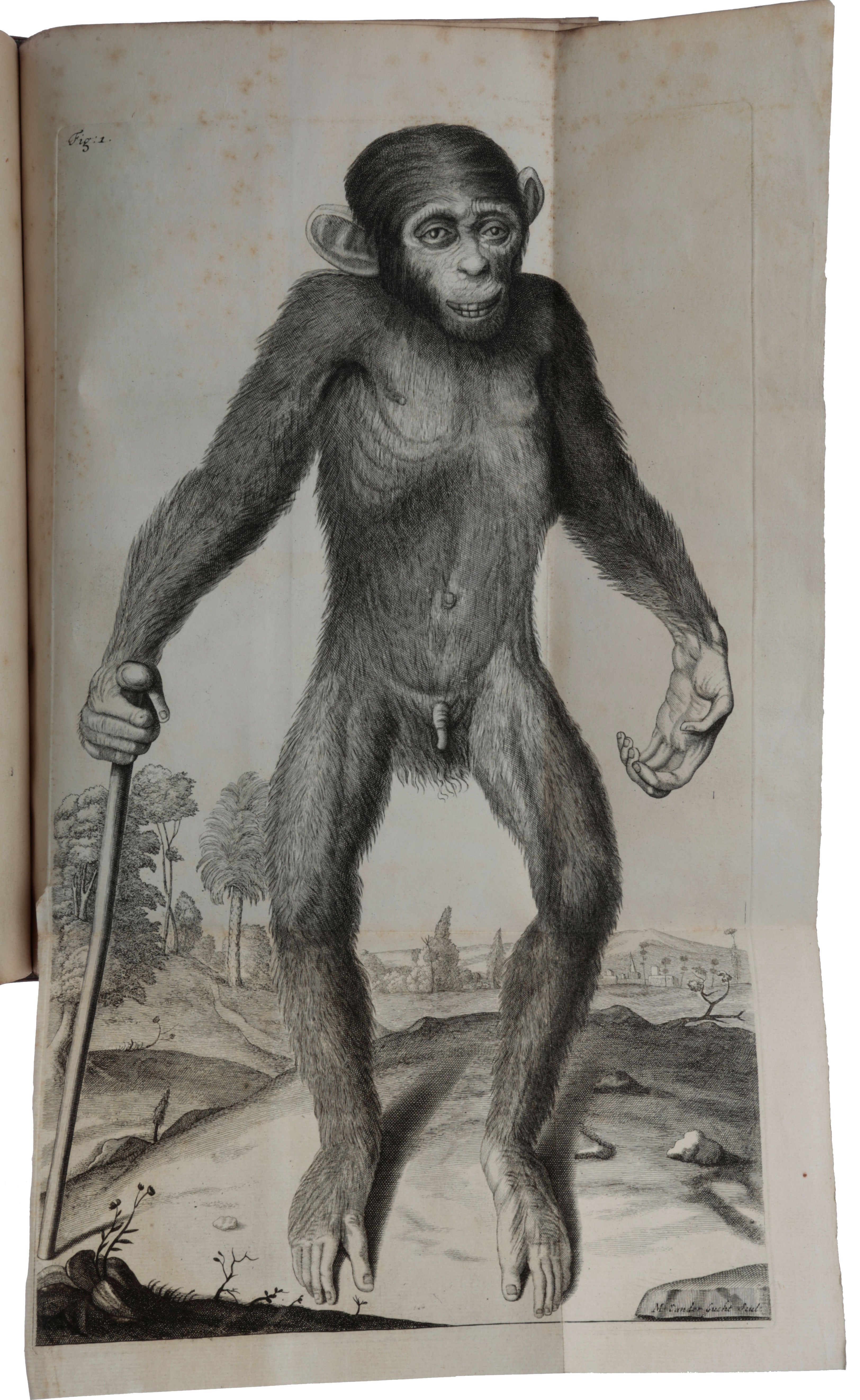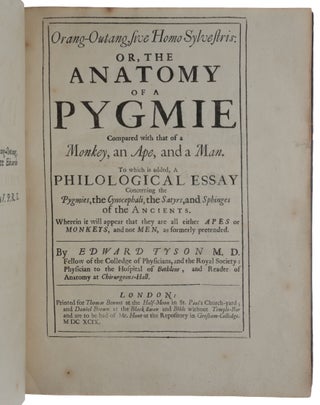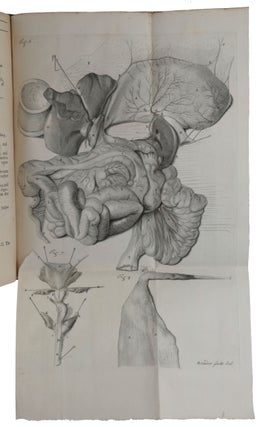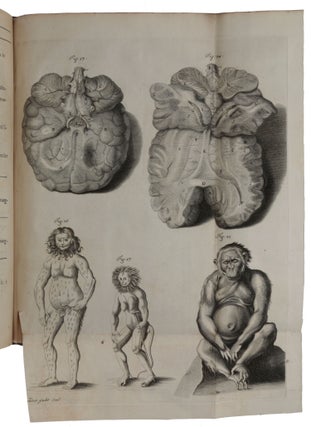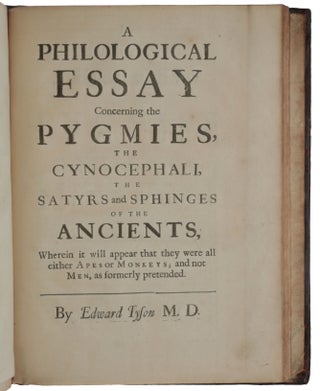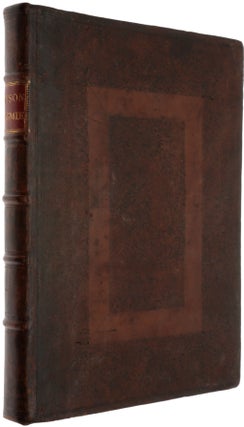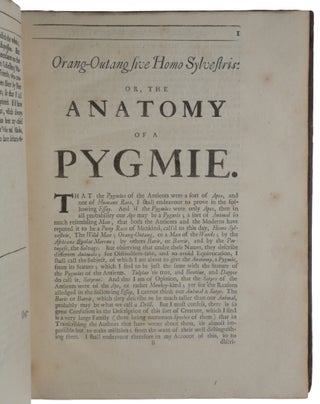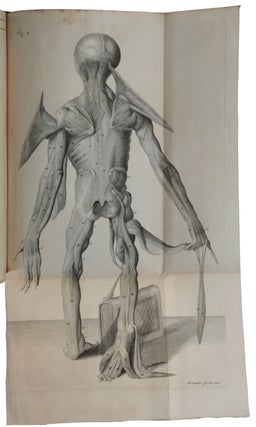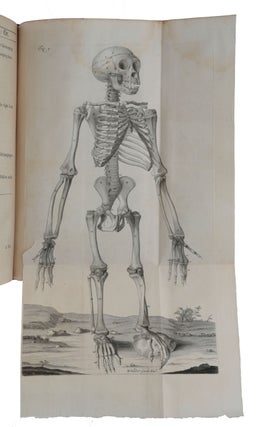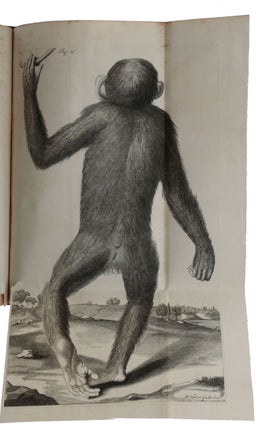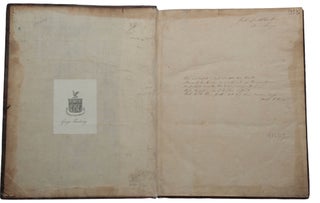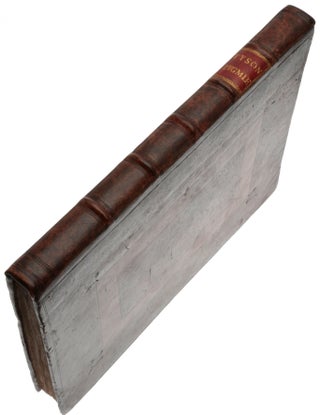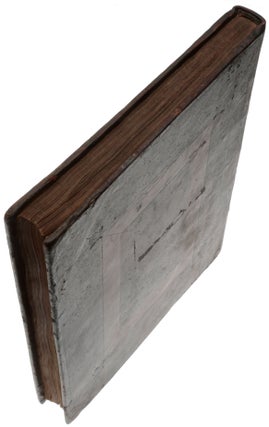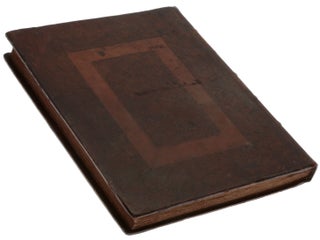Orang-Outang, sive homo sylvestris; or, the anatomie of a pygmie compared with that of a monkey, an ape and a man. To which is added, a philological essay concerning the pygmies, the cynocephali, the satyrs, and sphinges of the Ancients. Wherein it will appear that they are all either apes or monkeys, and not men, as formerly pretended.
London: Printed for Thomas Bennet … and Daniel Brown … and are to be had of Mr. Hunt at the Repository in Gresham-College, 1699. First edition, and a fine, tall copy, of “Tyson’s anatomy of the ‘Orang-outang’ (actually a young chimpanzee), which was the first work to demonstrate scientifically the structural relationships between man and anthropoid ape” (historyofinformation.com). It was “the earliest important study in comparative morphology … [Tyson] established a new family of anthropoid apes standing between monkey and man … [he] did not foresee the theory of evolution, but his work contributed substantially to its formulation and in that sense he was a forerunner of Blumenbach, Buffon, Huxley and Darwin” (PMM). “For Tyson the term Orang-Outang meant ‘man of the woods.’ In 1641 the Dutch surgeon and anatomist Nicholas (or Nicolaes) Tulp had used the same words to describe a chimpanzee, which he illustrated in his Observationum medicarum. This book included the first, limited description by a scientist of an African anthropoid ape. Regarding Tulp’s description Tyson said that ‘I confess that I do mistrust the whole representation.’ The ape which Tulp described seems to have come from Angola, and Tulp had the opportunity to observe it in the private menagerie of the Prince of Orange. Tulp seems to have learned the name orang-outang from Samuel Blomartio, a friend who had lived in Borneo and was familiar with the Javanese word for ‘man of the woods.’ Tulp seems to have been under the impression that orangutans were widely distributed throughout the tropics rather than limited to Asia, and thus confused the two species. The classification of the orangutan in the Ponginae (Pongo) subfamily of the family hominidae, outside of the subfamily homininae from which humans descend, and to which the chimpanzee belongs, had not yet occurred. Perhaps with some humor, but also to confirm the anatomical similarities, Tyson had Cowper draw the standing dissected figures of chimpanzees in the style of the famous Vesalian musclemen. A believer in the ‘Great Chain of Being’ or scala naturae, Tyson identified the chimpanzee as the link directly below mankind, stating in his ‘Epistle Dedicatory’ that it ‘seems the Nexus of the Animal and Rational.’ Tyson's anatomical study – the first conducted of a great ape – had a powerful influence on all subsequent thought on man’s place in nature. Thomas Huxley referred to it extensively in his 1863 book Evidence as to Man's Place in Nature. Tyson’s last section of Orang-Outang is devoted to ‘A Philological Essay Concerning the Pygmies of the Ancients,’ an early contribution to the study of primate-oriented folklore” (historyofinformation.com). This copy is a centimetre taller than the Norman copy. Provenance: Signature of John Cuthbert (d. 1782) on the front free endpaper, with five lines from Milton's Paradise Lost (slightly misquoted) in his hand below. Cuthbert was a governor of the Inner Temple (one of London’s four Inns of Court, or professional associations for lawyers), and a member of the Royal Society; 19th century armorial bookplate of George Thackeray (1777-1850), Provost of King’s College, Cambridge, and great-uncle to the author of Vanity Fair, William Makepeace Thackeray. “By almost universal consent Tyson’s greatest and most important work was published in 1699 with the title Orang-Outang, sive Homo Sylvestris: or, the Anatomy of a Pygmie Compared with that of a Monkey, an Ape, and a Man. Tyson did not use the term Orang-Outang in its modern sense as applied to a member of the Pongo family, but literally in the sense of ‘man of the woods’, for it was a chimpanzee that he described. He was copying Nicholas Tulp who used the same words to describe the chimpanzee which he illustrated in his Observationum Medicarum (1641) … “In this description of a young male chimpanzee, Tyson was at pains to point out that his ‘pygmie’ was not a monkey but was in fact a creature very near to man in many details of his anatomy. It was Tyson with this book who ‘initiated the anatomical study of the man-like apes, and who was virtually responsible for instituting a new family of hominoid apes intermediate between man and monkeys’ (Cole, p. 219). “Tyson added to the purely anatomical description of his chimpanzee a philological essay in which he pointed out that the ‘Pygmies, the Cynocephali, the Satyrs, and Sphinges of the Ancients’ were in fact apes or monkeys and not men. “The book was well received by his contemporaries but, as we shall see, a most important point raised by Tyson was not appreciated; it was, in fact, made too far in advance of its time. “The Philosophical Transactions published a review which cleverly abstracted the main feature of the book, which said: ‘The Ingenious Author of this Treatise, having often obliged the World with his Anatomical Discoveries and Observations on several curious Subjects, … has here given us a very Ample, as well as Accurate Account of this strange, and indeed surprising Animal, a creature rarely, if ever seen by our World.’ “The review ends by calling the book ‘this Learned and Ingenious Treatise’. It stresses the various anatomical features by which the chimpanzee most closely resembles man. “The account of the muscles was written by William Cowper who also drew the illustrations which were engraved by Michael van der Gucht: ‘I am obliged to my good Friend Mr. Cowper, not only for designing all my figures; but obtained of him likewise to draw up this ensuing account of the Muscles; whose great Skill and Knowledge herein, is sufficiently made evident by his Myotomia Reformata, or, New Administration of all the Muscles in Humane Bodies, published some time since: To which I refer my Reader, for a fuller account of them, whenever ‘tis said, that such and such Muscles in the Pygmie resembled those in Humane Bodies’ … “However, by far the greatest tribute came from Albrecht von Haller in his Bibliotheca Anatomica (1774-77), when he said ‘Nihil habemus in comparata anatome huic opera comparabile’ [‘We have no works that compare with this comparative anatomy’]. This is praise indeed … “… in order to view Tyson’s Orang-Outang in its true perspective it is important that we should compare his descriptive anatomy with that presented in books of human anatomy written in the same period. We should, in fact, adopt the same comparative approach with regard to the work as a whole that Tyson adopted with the anatomical features of his pygmie. This becomes necessary because it was most unusual at this time for a monograph to be devoted to the discussion of a single animal; Tyson’s books are almost unique in this regard. It must be remembered, too, that in his day the higher anthropoids were virtually seen only by travellers and their anatomy quite unknown. The chimpanzee was seen and illustrated in Europe only once before, the orang-utan was not to be described until 1779 and the gorilla was not discovered until 1847. “Seen in this light Tyson’s descriptive anatomy of the chimpanzee, here dissected for the first time, is a remarkable achievement. He sets about his description in a thoroughly modem, workmanlike fashion with a complete grasp of the literature which is freely quoted. When he wants to compare his anatomical findings with those of man he marshalls his facts methodically, with clarity, economy of words and with complete confidence. “So far as British authors are concerned the books on human anatomy which can be set against Tyson’s work for their originality and breadth of vision are those of his friends and contemporaries James Keill, William Cowper, Humphry Ridley, Richard Lower and Tyson’s more senior colleague Thomas Willis. “Read today, with the knowledge of all that has been discovered since Tyson's death, his Orang-Outang is still a great book. “As an example of his astute observation the following extract may be quoted: ‘The Hair of our Pygmie or Wild Man was of a coal-black colour, and strait; and much more resembling the Hair of Men than the Furr of Brutes; … The tendency of the Hair of all the Body was downwards; but only from the Wrists to the Elbow ‘twas upwards; so that at the Elbow the Hair of the Shoulder and the Arm ran contrary to one another.’ “This is the first recorded observation of the reversal of hair tracts on the arms of the higher apes and man, an observation later to be made by Charles Darwin in The Descent of Man. “To his descriptive anatomy Tyson adds careful measurements of all parts of the body of his chimpanzee, probably the first use of the modern science of anthropometry. The skeleton of his pygmie is still extant in the British Museum and Ashley Montagu has checked Tyson’s measurements of this with complete agreement. “One feature of his book remained hidden to his contemporaries but its importance was not lost to his successors. This was Tyson’s repeated assertion of the place occupied by his ‘pygmie’ in the scale of nature, for although he said it was not a man he placed it in an intermediate position between the monkeys and man. “Sir Thomas Browne in Religio Medici (1642) declared that there was ‘in this Universe a Stair, or manifest Scale of creatures, rising not disorderly, or in confusion, but with a comely method and proportion’; Tyson, who obviously studied Browne, says the same thing in the dedication of his book to Lord Evesham: ‘’Tis a true Remark, which we cannot make without Admiration; That from Minerals to Plants; from Plants, to Animals; and from Animals, to Men; the Transition is so gradual, that there appears a very great Similitude, as well between the meanest Plant, and some Minerals; as between the lowest Rank of Men, and the highest kind of Animals.’ “But he goes on to make a more significant remark: ‘The Animal of which I have given the Anatomy, coming nearest to Mankind; seems the Nexus of the Animal and Rational, as your Lordship, and those of your High Rank and Order for Knowledge and Wisdom, approaching nearest to that kind of Beings which is next above us; Connect and Visible and Invisible World.’ “With complete clarity of argument Tyson says: ‘What I shall most of all aim at in the following Discourse, will be to give as particular an Account as I can, of the formation and structure of all the Parts of this wonderful Animal and to make a Comparative Survey of Men, with the same Parts in a Humane Body, as likewise in the Ape and Monkey-kind. For tho’ I own it to be of the Apekind, yet, as we shall observe, in the Organization of abundance of its Parts, it more approached to the Structure of the same in Men: But where it differs from a Man, there it resembles plainly the Common Ape, more than any other Animal.’ “Later he concludes: ‘But at the same time I take him to be wholly a Brute, tho’ in the formation of the Body, and in the Sensitive or Brutal Soul, it may be, more resembling a Man, than any other Animal; so that in this Chain of the Creation, as an intermediate Link between an Ape and a Man, I would place our Pygmie. “No statement could be more clear than this and with it Tyson laid the basis for the scientific thought which culminated in Thomas Henry Huxley’s Evidence as to Man’s Place in Nature (1863) and Charles Darwin’s The Descent of Man (1871). It is strange that while Huxley mentions Tyson and praises his work, Darwin does not” (Russell). “Generally the anatomical description [in Tyson’s Orang-Outang] is quite thorough and competent, particularly considering how little comparative, nonhuman primate material was then known in Europe. For comparative material Tyson relied quite heavily on the description of monkeys in Alexander Pitfield’s English translation of the Parisians’ Mémoires. Tyson concluded with a table of the ways his ‘Pygmie’ more resembled a man than an ape, and vice versa, concluding that it belonged between man and the apes. He was surprised that the orangutan’s brain was so similar to that of man, because there is so much difference between a man’s soul and the soul of the brutes that one would expect a greater difference in their respective organs of the soul. For Tyson, comparative anatomy was a means of understanding and of determining the order of the animals on the Great Chain of Being. Tyson repeatedly emphasizes how close the structure of his Pygmie is to that of man and that the Pygmie is the closest approach of the animal kingdom to the rational qualities of man. While the notion of the Great Chain has a history that long antedates Tyson, he did, in this first anatomical description of one of the great apes, clearly identify an occupant for the rung immediately below man. The identification of such gradational links was one of his objectives for comparative anatomy” (DSB). “The second portion of Tyson’s book in which he shows by skilful argument that the pygmies and satyrs of the ancients were not men but were either apes or monkeys does not, in modern eyes, have the same importance as that on the Orang-Outang. Much of his treatise would seem to be influenced by the chapter on 'pigmies' by Sir Thomas Browne in his Pseudodoxia Epidemica (1646)” (Russell). Tyson (1651-1708) received a BA and MA from Oxford and an MD from Cambridge before being admitted to the Royal College of Physicians on 30 September 1680 and as a Fellow in April 1683; he was elected a Fellow of the Royal Society in November 1679. In 1680, Tyson studied the porpoise, established that it is a mammal, and noted that the convoluted structure of its brain was closer to those of land quadrupeds than those of fish. Following his Orang-Outang, Tyson dissected a timber rattlesnake in 1683 and produced one of the earliest and most accurate descriptions of the internal anatomy of snakes. Garrison-Morton 153; NLM/Krivatsy 12028; PMM 169; Wing T-3598; Norman 2120; Spencer, Ecce Homo. An Annotated Bbiliographic History of Physical Anthropology (1986) no. 1.92. Cole, A History of Comparative Anatomy, 1949. Russell, ‘Edward Tyson’s Orang-Outang,’ Medical History 11 (1967), pp. 417-23.
4to (282 x 215 mm), pp. [12], 108, [2], 58, [2], with 8 folding engraved plates after drawings by William Cowper by Michael Vander Gucht, signed ‘M. Vander Gucht scul.’ Contemporary panelled calf (expertly rebacked and with corners skilfully and almost unnoticeably repaired), boxed.
Item #5291
Price: $22,500.00

